- Quick Read
- Deep Read ( 11 Min. )
In Today’s Issue
- Will ‘Texas tough’ work in fighting fentanyl fatalities?
- Today’s news briefs
- ‘Time for us to leave’: Gaza reporter, again, joins thousands fleeing
- In Taiwan election, voters seek to protect island’s autonomy
- How women’s employment hit a record high in US
- Transforming LA: This artist sees hope where others see decay
Monitor Daily Podcast
- Follow us:
- Apple Podcasts
- Spotify
- RSS Feed
- Download
TODAY’S INTRO
A Monitor reporter flees her home
 Mark Sappenfield
Mark Sappenfield
The biggest enemy of the news is apathy. Breaking news settles into patterns. Patterns repeat. Attention wanes.
That is why I encourage you to read Ghada Abdulfattah’s story of her flight to safety. She’s been writing about internal displacement in Gaza for weeks. Yet there is something about someone’s own story – the story of someone we know – that shakes and awakens.
It is not the Monitor’s job to decide for nations or readers the matters of war and security. But it is the Monitor’s job never to accept that inhumanity anywhere must be inevitable.
Share this article
Link copied.

Help fund Monitor journalism for $11/ month
Already a subscriber? Login

Monitor journalism changes lives because we open that too-small box that most people think they live in. We believe news can and should expand a sense of identity and possibility beyond narrow conventional expectations.
Our work isn't possible without your support.
Will ‘Texas tough’ work in fighting fentanyl fatalities?
Fentanyl is a leading cause of death for Americans ages 18 to 45. Texas is taking a largely tough-on-crime approach, while critics urge a new approach prioritizing addiction treatment and prevention.

Like other states, Texas is struggling with a surge in fatal overdoses from fentanyl.
But how to stop the fatal overdoses? In 2023, Texas Gov. Greg Abbott declared a “war on fentanyl,” which is now a leading cause of death for Americans ages 18 to 45. The Legislature, at his urging, passed two laws increasing criminal penalties related to the drug.
Critics decry the tough Texas approach as a throwback to the war on drugs, launched in the 1970s, which resulted in mass incarcerations without meaningfully addressing drug-related crime and addiction.
Even while the Lone Star State emphasizes the punitive approach, pressure is building to recognize the challenge as a public health issue – and state lawmakers have nodded in that direction. Particularly at the local level, officials are pushing for more support for addiction treatment, as well as expanding access to overdose prevention tools.
“The two opposite policy approaches are happening at the same time. And sometimes, curiously enough, in the same places,” says Magdalena Cerdá, director of the Center for Opioid Epidemiology and Policy at NYU Langone Health. “If we actually want to improve things for other people, to prevent other people from dying, we need to figure out what works.”
Will ‘Texas tough’ work in fighting fentanyl fatalities?

In August 2022, Janel Rodriguez got a call from a mother she didn’t know. Her teenage son, Noah, had overdosed. She rushed over to the mother’s home, but she didn’t need to go inside to know her son was dead. Instead, she sank to her knees as every moment of Noah’s short life flashed before her eyes.
He’d grown from being an obedient, mild-mannered child to an angsty, troubled teen with the early wisps of a mustache. In between there had been birthday parties, vacations, and football games. He’d wanted to be an engineer, then he’d wanted to be an underwater welder. He’d never wanted to fatally overdose.
Screaming and crying, Ms. Rodriguez relived it all in seconds. She had to wait much longer to find out who had sold Noah the fentanyl-laced drugs. When she finally did, a prosecutor asked her how tough a punishment she wanted.
“I was really torn,” she says. “All I could think about was his mom.”
The defendant had just turned 19. Legally he’s an adult, she thought, “but he’s still a child.” On the other hand, Noah had been one of four children to die from fentanyl overdoses in her Texas community, Hays County, since that summer. And by the next summer, two more children had died.
She spent a week sorting through her emotions, then she told the prosecutor she wanted the toughest possible sentence.
“I have to do what’s best for Hays County, and if that means putting this person away for 20 years, then that’s what I’ve got to do,” she says.
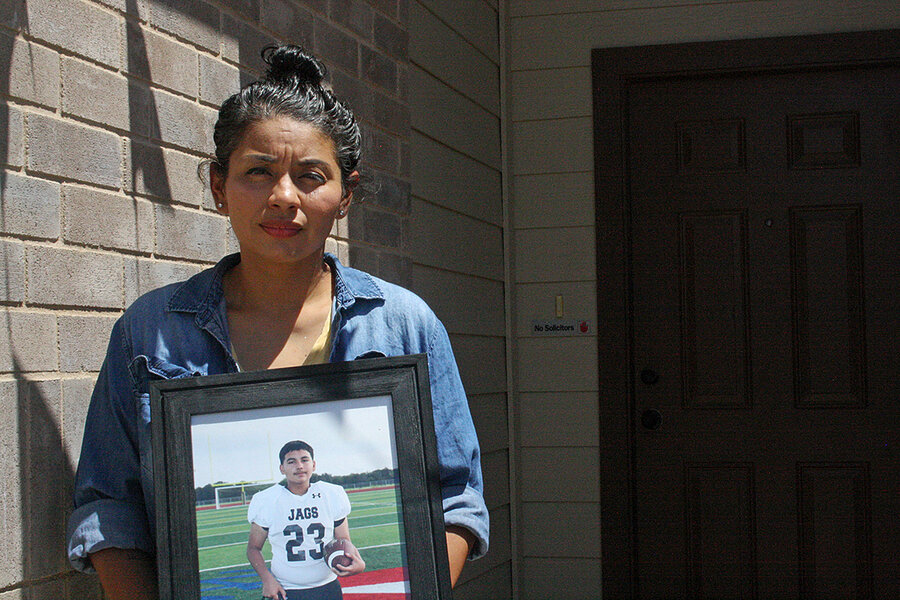
In 2023, Texas leaders listened to sentiments like those of this grieving mother. Gov. Greg Abbott declared a “war on fentanyl,” and the Legislature, at his urging, passed two laws increasing criminal penalties related to the drug. Like other states, Texas is struggling with a surge in fatal overdoses from this synthetic opioid, which is considered up to 50 times stronger than heroin. Deaths from fentanyl-related overdoses in Texas more than quintupled from 317 to 1,612 between fiscal years 2019 and 2021, according to state data. Fentanyl is now a leading cause of death for Americans aged 18 to 45.
But how to stop the fatal overdoses? Critics decry the tough Texas approach as a throwback to the war on drugs, launched in the 1970s, which resulted in mass incarcerations without meaningfully addressing drug-related crime and addiction. In many ways, the opioid crisis today is more formidable and complex than America’s past drug crises. Opioids are deadlier, more addictive, easier to hide, and more manipulable than any narcotic the United States has tried to police before. Neither dealers nor users may know fentanyl is present in a drug, blurring the idea of what justice should look like.
The issue takes on added urgency as state, local, and tribal governments begin to consider how to spend upward of $50 billion coming their way over the next 18 years – the result of legal settlements with opioid manufacturers and distributors. And in November, the U.S. and China announced an agreement that would see China – a major source of precursor chemicals used to manufacture fentanyl – curtail shipments of those chemicals and share more information about suspected international drug trafficking.
But the fentanyl challenge is confounding, and states are searching for the best path forward. Even while the Lone Star State emphasizes the punitive approach, pressure is building to recognize the challenge as a public health issue – and state lawmakers have nodded in that direction. Particularly at the local level, officials are pushing for more support for addiction treatment and recovery, as well as expanding access to overdose prevention tools.
“The two opposite policy approaches are happening at the same time. And sometimes, curiously enough, in the same places,” says Magdalena Cerdá, director of the Center for Opioid Epidemiology and Policy at NYU Langone Health. “If we actually want to improve things for other people, to prevent other people from dying, we need to figure out what works.”
Tough laws not stopping overdoses
America is now in the fourth wave of the opioids crisis. Texas resident Joshua Bell lived through three of them.
The Vicodin prescription doctors gave him after a 2010 car accident was “like the first time experiencing love,” he said a few years later. Like countless Americans, he became hooked on prescription opioids – the first wave. When authorities began cracking down on these prescription drugs, the second opioids breaker crashed ashore. Like so many other people, he turned to heroin.
Mr. Bell survived that second pummeling, too. He went to rehab; he got sober. When he moved to College Station, Texas, with his girlfriend, the third wave of the crisis – synthetic opioids, e.g., fentanyl – was rolling over the country, soon to be followed by the fourth wave, synthetic opioids mixed into other drugs. “He was doing really well,” says his mother, Annie Hernandez. “Until he wasn’t.”

One night, he bought Xanax laced with a few nanograms of fentanyl, and fatally overdosed. It was 2019, the year fentanyl became widespread in the U.S. and overdose deaths began to spike. Almost 71,000 people died from drug overdoses that year, about half from synthetic opioids, according to the U.S. Centers for Disease Control and Prevention. In 2021, the last year for which data is available, almost 107,000 died from drug overdoses, with more than two-thirds of those involving synthetic opioids.
The same trends have occurred in Texas. Last year, the state responded by increasing criminal penalties for possessing or selling fentanyl. State lawmakers also passed a law that empowers prosecutors to bring murder charges against people who sell fentanyl that leads to a fatal overdose. Similar drug-induced homicide laws are now on the books in around 30 states.
But decades of research into the war on drugs, launched by President Richard Nixon, show that tough, punitive drug policies – such as drug-related homicide laws, passed in the 1970s and ’80s – have failed to get at root causes and have had unintended, costly consequences. Meanwhile, fatal drug overdoses are increasing.
A fifth of those incarcerated in America are behind bars for drug offenses, disproportionately affecting people of color and causing long-term collateral damage to them and their families. As of 2021, the U.S. had spent over $1 trillion enforcing its drug policy, CNBC reported that year, which was the 50th anniversary of the war on drugs. Drug overdose deaths initially declined but began to rise in the 1980s, and have risen much more steeply in this century. A veteran Baltimore police officer told NPR that the drug war has “failed” and “does not belong in our wheelhouse.”
Texas lawmakers who favored increased penalties for selling fentanyl – and even for possessing it – argued that current laws don’t have enough teeth to punish high-level dealers who make millions off of street-level users. State Rep. Craig Goldman, who co-sponsored the drug-induced homicide law, told the Fort Worth Star-Telegram the intent of the law is to go after “the individuals doing this on a grand scale.”
Yet tying drug use to criminal punishment “dissuades people from seeking help” with addiction problems, perpetuating their addiction, according to the Drug Policy Alliance, an advocacy group that seeks to end the drug war.
Tough-on-crime responses are partly responsible for the rise of fentanyl, according to experts. The crackdown on the overprescribing of legal opioids in the 2010s created a demand for illicit opioids like heroin and, later, fentanyl.
“The emergence of fentanyl ... is the result of missteps in how this crisis was addressed in previous years,” says Leo Beletsky, a professor at Northeastern University School of Law who researches homicide laws tied to drug overdoses.
Speaking of such laws, he says, “The reality is that prosecutions often target friends, relatives, and other people who may be present at overdose scenes.” The theory that arresting high-level dealers will prevent fatal drug overdoses “has never been [supported by] any kind of empirical evidence,” he adds.
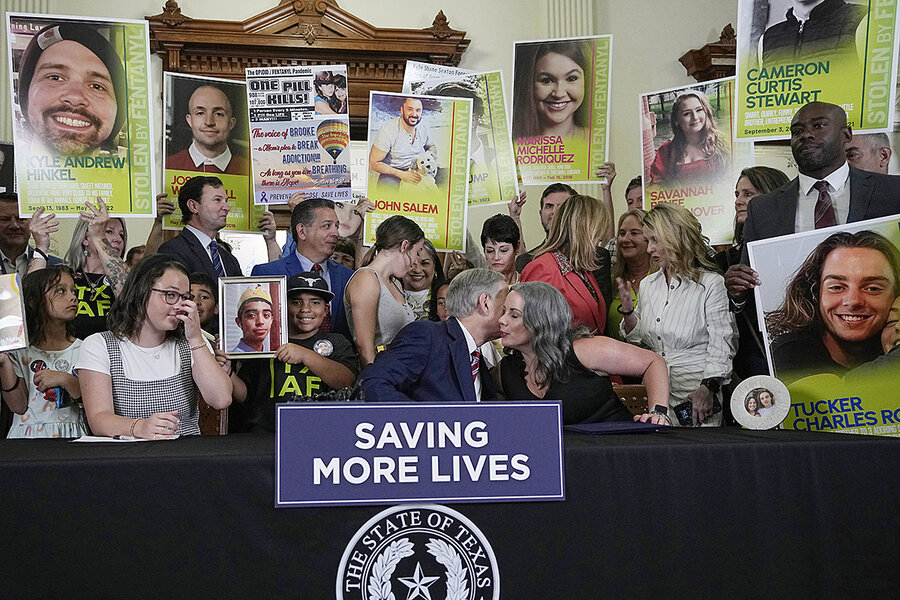
What if Noah had gone into rehab?
Entering 2022, Noah was struggling not just with pandemic schooling and teenage angst, but also with addiction issues. His mother had been noticing changes.
With schools shut down, he started hanging out with a new group of friends, coming home smelling of marijuana some nights. And in May 2022, she got a call from the local police: Noah and three friends had taken cocaine, and Noah was unresponsive. After a week in the hospital, he came home and committed to turning his life around. He apologized, telling his parents, “I don’t want to die.”
“Summer 2022 was the best summer with Noah we remember,” says Ms. Rodriguez. He continued to wrestle with drug use, but he was present and honest, and enjoyed spending time with his family, she recalls. And then came the overdose.
“I don’t regret anything I did as a parent,” she adds. “But I feel like if he was just given the chance to go into rehab, it could possibly have had a different outcome.”
In this context, it’s important to note what Texas, at the state level at least, hasn’t done. Expanding access to treatment, especially for minors, is one. A bill to legalize fentanyl test strips – which allow drug users to test if a substance is laced with fentanyl, and are legal in roughly 40 states – failed in Texas last fall despite overwhelming bipartisan support in the state House of Representatives.
The Legislature did pass a 2023 bill requiring public school campuses to be stocked with Narcan, a popular overdose-reversal medication, and the state did launch a $10 million awareness campaign last year. But the state’s continued refusal to participate in expanded Medicaid also “means fewer resources to help cover the cost of drug treatment, not to mention the many other health care needs that left untreated can increase the risk of drug use and addiction,” says Katharine Neill Harris, a drug policy expert at Rice University’s Baker Institute for Public Policy.
This environment makes it difficult for Texas to widely adopt what are known as “harm reduction” practices. As criminalization has failed to protect people from drug overdoses – and as the decriminalization of drug use in places such as Oregon has, so far, not reduced overdose deaths either – harm reduction approaches seek to make drug use as safe as possible, preventing overdoses in the short term while helping people get clean in the long term.
These approaches, such as making overdose reversal medications, drug-checking technologies, and syringe services more available, do have significant public health benefits, according to the National Institute on Drug Abuse.

“We just haven’t addressed the demand for drugs. We’re just not doing that the way we should be,” says Dr. Neill Harris. That’s why harm reduction is so important, she says.
“All these structural problems that make people feel like their lives aren’t worth living ... those problems we’re just not dealing with,” she adds. “And because we’re not dealing with that, we should be trying to make drug use less harmful for people who do use drugs.”
A two-pronged approach
While Texas has favored a mostly law enforcement response to the opioid crisis, those tasked with enforcing that response acknowledge they’re in a tricky position: Fentanyl is illegal, and a threat to public safety, but the underlying addiction problems in society are public health issues.
What are prosecutors, for example, to do?
The county with the most fentanyl-related overdose deaths in Texas through the first half of 2023 – Harris County, home to Houston – is trying a two-pronged strategy.
Last spring the Harris County district attorney’s office added fentanyl-related overdose deaths to its caseload. The agency’s major narcotics unit works with local law enforcement and the U.S. Drug Enforcement Administration on major fentanyl trafficking cases.
“We’ve kind of had to add one more hat that we wear,” says Garrett Moore, chief of the narcotics section in the district attorney’s office.
What Mr. Moore’s office does not handle, however, are low-level fentanyl possession cases. Those cases are automatically diverted to the Responsive Interventions for Change court. Founded in 2016, the specialty court aims to connect defendants to treatment and resources instead of locking them up. Since its creation, the county has seen the recidivism rate for high-risk defendants drop from 60% to 32%, according to the district attorney’s office. The court has also helped lower the number of people being held by the overwhelmed county jail system.
The diversion effort is being replicated in “a lot of places” outside of Texas, says Dr. Neill Harris. “It’s not a silver bullet, but it’s better than incarcerating people.”
Historically, incarceration is what followed the enhancement of criminal penalties. Crack cocaine laws in the 1980s and ’90s, for example, carried heavy punishments for simply possessing the substance – penalizing users as much as dealers, and causing the incarceration rate of Black Americans to explode.
Drug-induced homicide laws have existed for decades as well, including for crack cocaine, but the Texas fentanyl law has an important update: focusing on selling instead of possessing.
In the fentanyl context, specific dealers can be dangerous. Fentanyl cases often involve a rash of fatal overdoses connected to a single dealer, such as two in the Dallas area last year who were allegedly tied to 10 overdoses, three of them fatal.
“If [a] dealer starts slinging fentanyl without telling people, or has a bad mix, you might get several overdoses out of it,” says Mr. Moore. “If these people are not prosecuted, they will continue to sell fentanyl.”
At the same time, buyers often don’t know they’re buying fentanyl, and dealers may not know either. Someone who buys a fentanyl-laced drug to take with friends may face murder charges if a friend dies from an overdose, as happened last year with a teenage girl in Tennessee.
For this reason, Mr. Moore hopes that prosecutors in the state will be selective in how and when they pursue the harshest punishments.
“We all need to be on board with the fact that the prison system is probably not the best place to try to treat people when their underlying issue is not a criminal issue, but a substance abuse issue,” he adds.
Prosecutorial discretion “becomes super important,” he continues, “so that we’re not recreating the crack epidemic in the ’80s for people who really need help.”
Editor's note: The affiliation of Magdalena Cerdá, one of the sources quoted in this article, has been corrected to read: NYU Langone Health. The article has also been corrected to read: Fentanyl is now a leading cause of death for Americans aged 18 to 45.

Today’s news briefs
• Republican faceoff: In their first head-to-head debate, U.S. presidential rivals Ron DeSantis and Nikki Haley will battle tonight at 9 p.m. EST to emerge as the clear alternative to front-runner Donald Trump.
• Ecuador attack on TV: A group of armed, masked men in Ecuador attacked a television station during a live broadcast. Police arrested 13 people. They will be charged with terrorism.
• Red Sea missile barrage: Yemen’s Houthi rebels launched their largest-ever Red Sea drone and missile attack. No damage was reported. The U.S. and British navies shot down the projectiles.
• U.S. emissions decline: Pollution from greenhouse gases in the United States declined by nearly 2%, according to a new report. The 2023 decline, however, is far below the rate needed to meet a White House pledge to cut emissions in half by 2030.

‘Time for us to leave’: Gaza reporter, again, joins thousands fleeing
The Monitor’s reporter in Gaza has been living the Israel-Hamas war, though it feels like more than just a war, she says. Driven by basic human needs – safety above all as fighting neared – her family looked urgently for a truck, and for a route south.
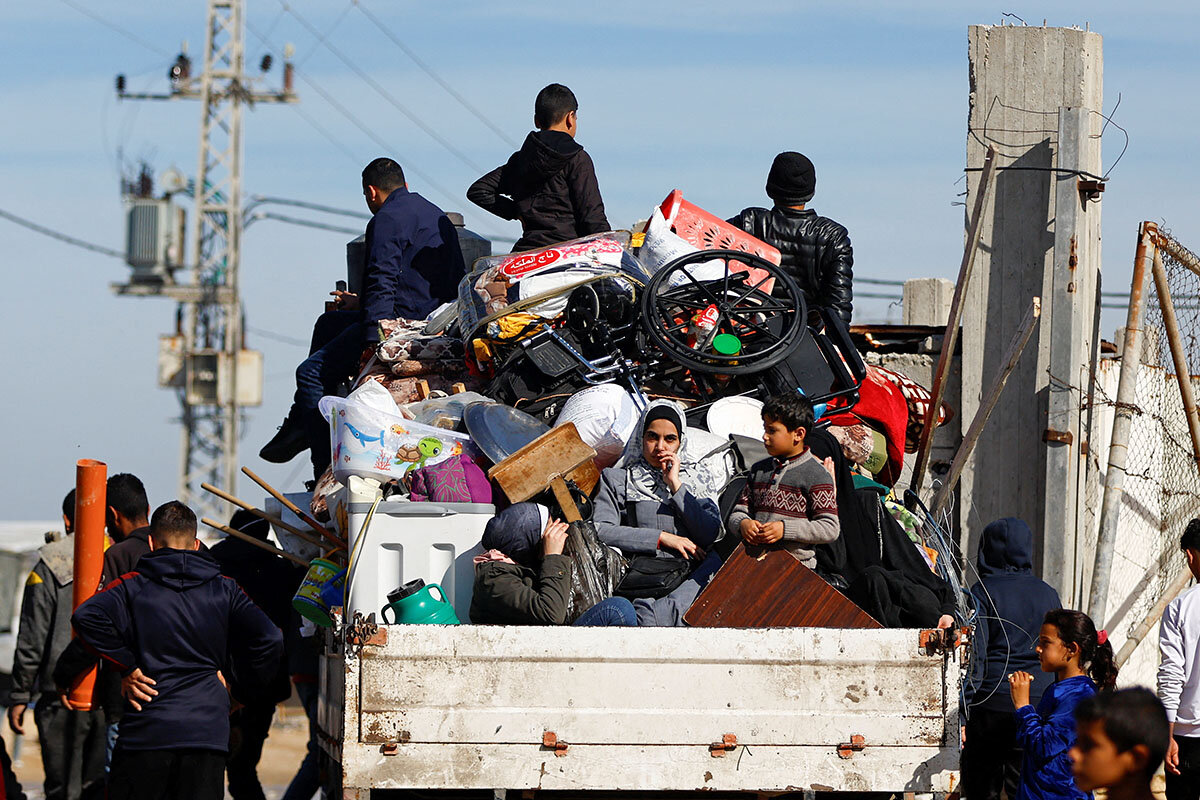
- Quick Read
- Deep Read ( 5 Min. )
-
By Ghada Abdulfattah Contributor
Monday morning, as part of my daily routine to gather fuel to bake bread, I went to collect grass from our backyard when my brother stopped me at the door. He warned me of Israeli drones buzzing overhead.
Intensified bombing was nearing our home in Deir al-Balah, and Israeli snipers were moving in a few hundred yards away. Later that day, when my brother and nephew went to shop for a bag of sugar, a can of beans, and cheese, they had to pass Israeli sniper posts. I tried calling them when they ran late but could not get through. We feared the worst for hours before they returned.
That was when my father decided. “I think it is time for us to leave,” he said.
With the encroaching fighting this week, one of the last bubbles of relative calm in central Gaza was shattered, sparking yet another exodus of thousands of Palestinians to the crowded southern border town of Rafah. We are now among them.
This year I have no resolution: not to get in shape, start a business, end a bad habit, or start a good one. I have a wish, our wish for 2024: for this war to end.
‘Time for us to leave’: Gaza reporter, again, joins thousands fleeing
Sunday night, my head heavy with congestion, I tried to sleep through a deepening chill.
I ached for a comforting hot tea. With no fuel, electricity, or hot water in my family home, I shook the thought from my mind and tried to go back to sleep.
Then the airstrikes began. I guessed it was in Maghazi camp, 2 miles away. The pitch-black night sky lit up in fiery hues of crimson and tangerine.
The next morning, as part of my daily routine to gather firewood to bake bread, I went to collect grass from our backyard when my brother stopped me at the door. He warned me of Israeli drones buzzing overhead.
With intensified bombing nearing our home in Deir al-Balah and Israeli snipers moving in a few hundred yards away, it became clear Monday that we, like thousands of other families, needed to evacuate to Rafah.
With the encroaching fighting this week, one of the last bubbles of relative calm in central Gaza was shattered, sparking yet another exodus of thousands of Palestinians to the crowded southern border town. The United Nations estimates that nearly 2 million of Gaza’s 2.2 million people are internally displaced.
We are now among them.
As of late last week, my brother Mohammed could not reach the hospital for his twice-weekly kidney dialysis without passing snipers.
On Monday, when my brother and nephew went to shop for a bag of sugar, a can of beans, and cheese, they had to pass Israeli sniper posts. I tried calling them when they ran late but could not get through. We feared the worst for hours before they returned.
That was when my father decided. “I think it is time for us to leave,” he said.
Over the past few days, I witnessed evacuees dismantle their tents at Deir al-Balah’s Al-Aqsa Hospital and relocate southward yet again in an effort to avoid encroaching gun battles and missiles.

We had already evacuated once to Rafah in October, but returned home during the November cease-fire because conditions in the south were cramped and supplies scarce. This had been our home since 2014, when our family house in Gaza City was destroyed by a missile in a previous Israel-Hamas war.
With fighting closing in on us, we needed again to find a way out.
The few trucks available for transportation – if you can convince drivers to cross areas cut off by snipers and tanks, and if you can locate fuel yourself – charge $500 for what in normal times is a 20-minute, 15-mile ride.
But these are not normal times.
Going by foot or donkey like thousands of other evacuees was not an option; my nieces and nephews are infants, and my brother cannot travel long distances along missile-cratered roads on a donkey cart due to his health.
Just days earlier, I had reported on evacuees from nearby Bureij and Maghazi camps desperately trying to flag down cars to head south. Now it was our turn to scramble for transport.
We called Abu Khalil, a driver who recently evacuated his own family from Maghazi to Rafah, but was still risking his life ferrying people for badly needed cash. He agreed to take us.
We hurriedly grabbed our emergency bags, a recently purchased sack of flour, mattresses, blankets, a fuel cylinder, personal documents, and a supply of olive oil.
When Abu Khalil arrived at 12:30 p.m., we crammed into the open bed of his truck and sat alongside our belongings, exposed to the elements – and potential gunfire or shrapnel.

As we were about to leave, my father refused to come, insisting on staying in the house. With time running short before sunset, we reluctantly drove off without him.
With the sharp winter wind whipping at our faces, my sister-in-law covered her children’s faces with a headscarf while my mother sobbed.
The truck zigzagged through side streets for two hours to avoid Israeli tanks on the main road south. Abu Khalil stopped every few minutes to ask passersby if they knew if the road ahead was clear.
We all have friends who have lost relatives, killed along the so-called safe corridor. We quietly prayed we would not get hit by an airstrike or drive in front of gunfire.
Streets were filled with people and donkey carts, carrying mattresses and the rare bag of food, all heading south, slowing our journey.
We tensed up when we reached Miraj, near the very location where fellow journalists Hamzeh Dahdouh and Mustafa Thuraya were killed in an Israeli airstrike one day earlier. Fearful of what lay ahead, Abu Khalil slowed to a crawl.
During the ride, under buzzing Israeli drones, my brother and I debated what we should call this war; we have lived through so many.
“This is not a war,” Mohammed finally concluded. I believe he is right. We have experienced wars, but we have never lived through “this” – displacement, expulsion, fear, poverty, hunger, and humiliation.
This “war” is our terror, our vulnerability, our hunger, our thirst.
Sitting in the back of the truck, as we passed demolished homes and rubble, I could not help but think about the lives lost, the people buried underneath.

One former colleague lost 47 members of his family in a single Israeli missile strike. I cannot fathom the idea. I do not even know how to offer him my condolences.
Finally, we arrived in Rafah at my sister’s apartment.
Since we were last here, the population has ballooned. The streets, the markets, every square foot of open space is crammed with people bustling to and fro. When you walk in Rafah, your shoulders are always touching the shoulders of another person; a man, a woman, it is too crowded to even tell.
Life in Rafah may be relatively less dangerous, but it is more difficult.
Mohammed had connections at the hospital by our home, but not here. A dialysis session scheduled for 11 p.m. last night at the Abu Yousef Al Najjar hospital was pushed back until 3 a.m. this morning.
Food is scarcer. On Tuesday, I scoured supermarkets and UNRWA schools for milk but returned empty-handed.
As we made our trip south, I was aware that people around the world were starting New Year’s resolutions.
This year I have no resolution: not to get in shape, start a business, end a bad habit, or start a good one. I have a wish, our wish for 2024: for this war to end.
Senior correspondent Taylor Luck contributed to this report from Amman, Jordan.

In Taiwan election, voters seek to protect island’s autonomy
At a key juncture, Taiwan’s voters will weigh in on who is best qualified to navigate geopolitical tensions and preserve the self-governing island’s autonomy.
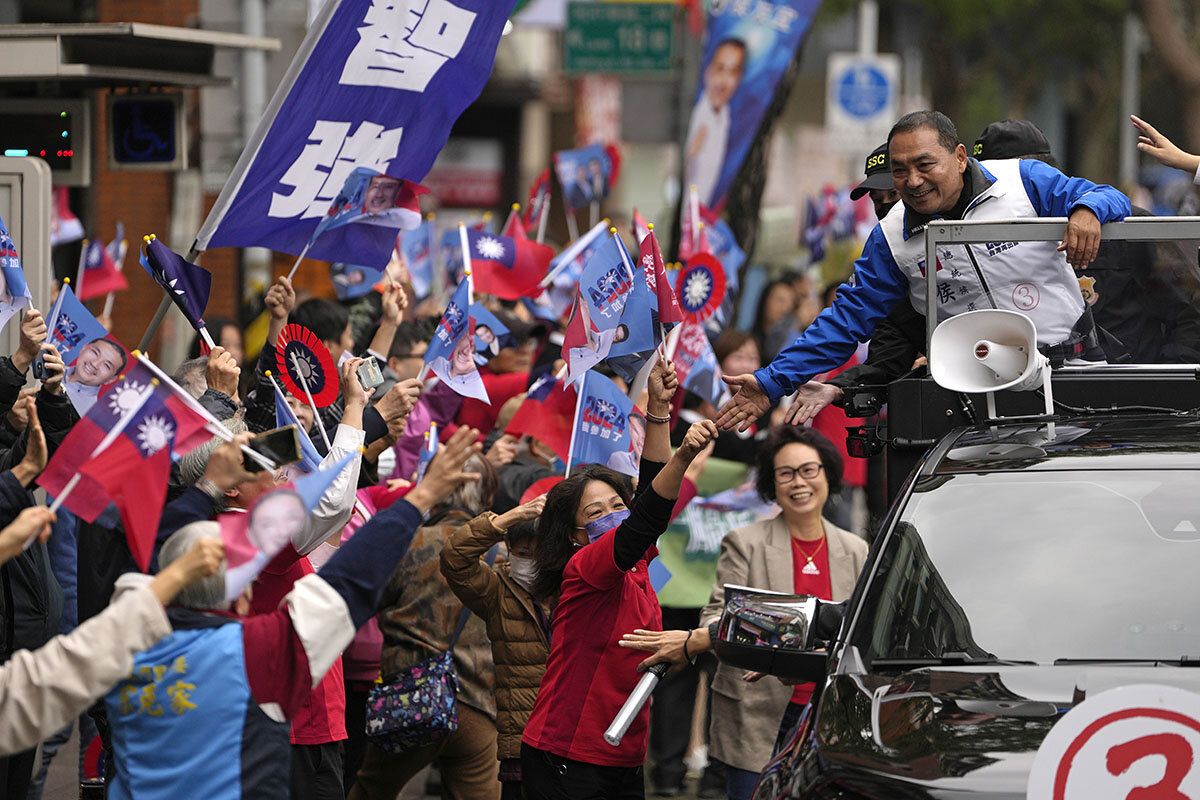
- Quick Read
- Deep Read ( 5 Min. )
Taiwan will pick a new president this weekend. The electorate’s goal? To maintain the status quo on the island – one of Asia’s most vibrant democracies – amid escalating pressure from China, a task that requires deftly managing relations across the Taiwan Strait.
“Voters are asking ... who will preserve Taiwan’s autonomy, and who will preserve the peace,” says Bonnie Glaser, managing director of the German Marshall Fund’s Indo-Pacific Program.
All candidates have pledged to avert conflict, and say they are open to dialogue with China. Indeed, candidates’ positions on Taiwan-mainland China relations are far more similar than in past decades, reflecting the popular consensus on the issue.
Leading the polls is Vice President Lai Ching-te, who stresses the need to strengthen relations with democratic allies in the West and Asia. But another strong contender is Hou Yu-ih, representing the Kuomintang, or the Nationalist Party, which is generally considered more pro-Beijing.
Mr. Hou has cast this election as a stark choice between war and peace – a message that Beijing is amplifying and could resonate with voters.
“I would not be astonished if Hou wins – he is narrowing the gap,” says Ms. Glaser. And if Dr. Lai is victorious, his party may lose its majority in Taiwan’s parliament, complicating the administration’s ability to advance its agenda.
In Taiwan election, voters seek to protect island’s autonomy
Taiwan will pick a new president this weekend – a choice centered on which candidate voters believe can best protect the island’s autonomy amid escalating pressure from China, which claims Taiwan as its territory.
Taiwan’s electorate overwhelmingly seeks to maintain the status quo on the island – one of Asia’s most vibrant democracies – a task that requires deftly managing relations across the Taiwan Strait. In addition to choosing president and vice president, voters will elect a new national legislature.
“Clearly, there are growing concerns in Taiwan about the possibility of military conflict, but voters are asking who is the best candidate, who will preserve Taiwan’s autonomy, and who will preserve the peace,” says Bonnie Glaser, managing director of the Indo-Pacific Program at the German Marshall Fund of the United States.
China has vowed to unite mainland China with Taiwan, by force if necessary, and has ramped up the activity of military aircraft, ships, drones, and recently balloons around the island, which at the closest point lies about 80 miles from the mainland across the Taiwan Strait.
All three of Taiwan’s presidential candidates have pledged to defend the island and avert conflict, and say they are open to dialogue with China. Indeed, the candidates’ positions on Taiwan-mainland China relations are far more similar than in past decades – a reflection of the popular consensus on the issue.
“They all talk about the need to protect Taiwan’s democracy, the need to build up Taiwan’s defense,” says Chong Ja Ian, associate professor of political science at the National University of Singapore. “The difference is not in broad principles, but in execution.”
Top candidates
Leading in the polls is Lai Ching-te, the candidate of the ruling Democratic Progressive Party (DPP) and Taiwan’s vice president. A win by Dr. Lai, a former doctor and seasoned politician, would mark a first for Taiwan – no political party has retained the presidency for three successive terms since democratic elections for the office began in 1996. President Tsai Ing-wen is stepping down after serving the maximum of two four-year terms.

“I will boost our democracy as well as our defense capabilities and economic security,” Dr. Lai said during a recent presidential debate.
In the view of Dr. Lai and the DPP, Taiwan is already de facto independent, so no formal declaration of independence is necessary. Dr. Lai also stresses the need to strengthen relations with Taiwan’s democratic allies in the West and Asia.
“The DPP wants to keep China at arm’s length,” says Nathan Batto, a research fellow at the Election Study Center, National Chengchi University in Taipei. “They are not trying to disengage with China ... but they are not trying to build new and closer ties.”
Another strong contender, representing the Kuomintang (KMT), or the Nationalist Party, is Hou Yu-ih, a former police officer who has been the mayor of New Taipei City since 2018. Mr. Hou is the candidate favored by Beijing. He opposes independence for Taiwan and maintains the longstanding KMT stance that there is “one China,” albeit defined differently by Beijing and Taipei. He favors closer economic and social interaction between mainland China and Taiwan.
The KMT and Mr. Hou have cast this election as a stark choice between war and peace – a message that Beijing is amplifying. That warning could resonate with voters because “there is more of a credible threat now” from China, says Dr. Batto, an associate research fellow at the Institute of Political Science, Academia Sinica.
KMT leaders moved to Taiwan from mainland China in 1949 after losing a civil war against China’s communist forces, and historically the KMT has backed unification with China. But in recent decades, the waning popularity of this position – as people in Taiwan increasingly identify as Taiwanese, not Chinese – has hurt the KMT. Fewer than 10% of people in Taiwan support unification, polls show. Mr. Hou does not endorse Beijing’s preferred “one country, two systems” formula for unification. In the debate, Mr. Hou said he supports “freedom and democracy” for Taiwan.
Narrowing the gap
A third candidate, Ko Wen-je, represents the Taiwan People’s Party, which he founded in 2019 as an alternative to the KMT and DPP. Dr. Ko, a former physician who was mayor of Taipei from 2014 to 2022, is a populist politician and advocate for change with appeal especially among young people. He promises to govern better and fight corruption. On China, he says he will take a middle road, charting a position between the KMT and DPP, although he has not yet articulated details of his plan.

The three candidates also share many similar domestic policy priorities – from increasing public housing to spending more on public health – but the KMT and DPP disagree on Taiwan’s use of nuclear energy, with the KMT supporting it and the DPP opposing it.
Based on the latest polling, Dr. Lai is slightly favored to win Saturday’s election, analysts say. But a victory by Mr. Hou can’t be ruled out, they say. Two scenarios could contribute to give Mr. Hou an edge: low DPP turnout, and the dimming prospects for Dr. Ko, evident in the polls, which could lead some of his supporters to back Mr. Hou instead.
“I would say Lai would eke out a victory, but I would not be astonished if Hou wins – he is narrowing the gap,” says Ms. Glaser, from the German Marshall Fund. “Is the DPP able to energize its base to get people to come out and vote?” And even if Dr. Lai does win, the DPP may lose its majority in Taiwan’s parliament, the Legislative Yuan, complicating a Lai administration’s ability to advance its agenda, she says.
The election is “too close to call,” says Scott Kennedy, a China expert and senior advisor at the Center for Strategic and International Studies in Washington.

How women’s employment hit a record high in US
The percentage of working women in the United States hit a record high in 2023 – defying expectations of a slow post-pandemic recovery.

Women in the U.S. workforce hit a milestone in 2023, when the percentage of prime-age working women reached 75.3% – an all-time high. The main driver of this increase: college-educated women with young children.
Women have outnumbered men in earning college degrees since the early 1980s. Yet the employment rate for women in the 25-to-54 age range still lagged behind that for men – and many economists expected them to have a slow post-pandemic return to work. So the recent trend is significant, as college-educated women with young children lead the way in employment growth.
This increase is tied to workplace changes like telecommuting that accelerated during the pandemic, although the trend predates COVID-19. And it’s largely independent of economic cycles, which was a surprise to researchers, who note the broader economy has affected other subsets of working women.
Women still face employment challenges. In 2022, men’s earnings averaged 18% more than women’s. Women are twice as likely as men to hold part-time jobs. The “child penalty” – the long-term effects of having children on a woman’s career – has shrunk but persists.
Overall, the rate of working mothers is expected to keep climbing.
“This is a positive for the U.S. economy,” says Alexander Arnon, an analyst with the University of Pennsylvania’s Penn Wharton Budget Model, who led a recent study of the data. – Ali Martin, staff writer
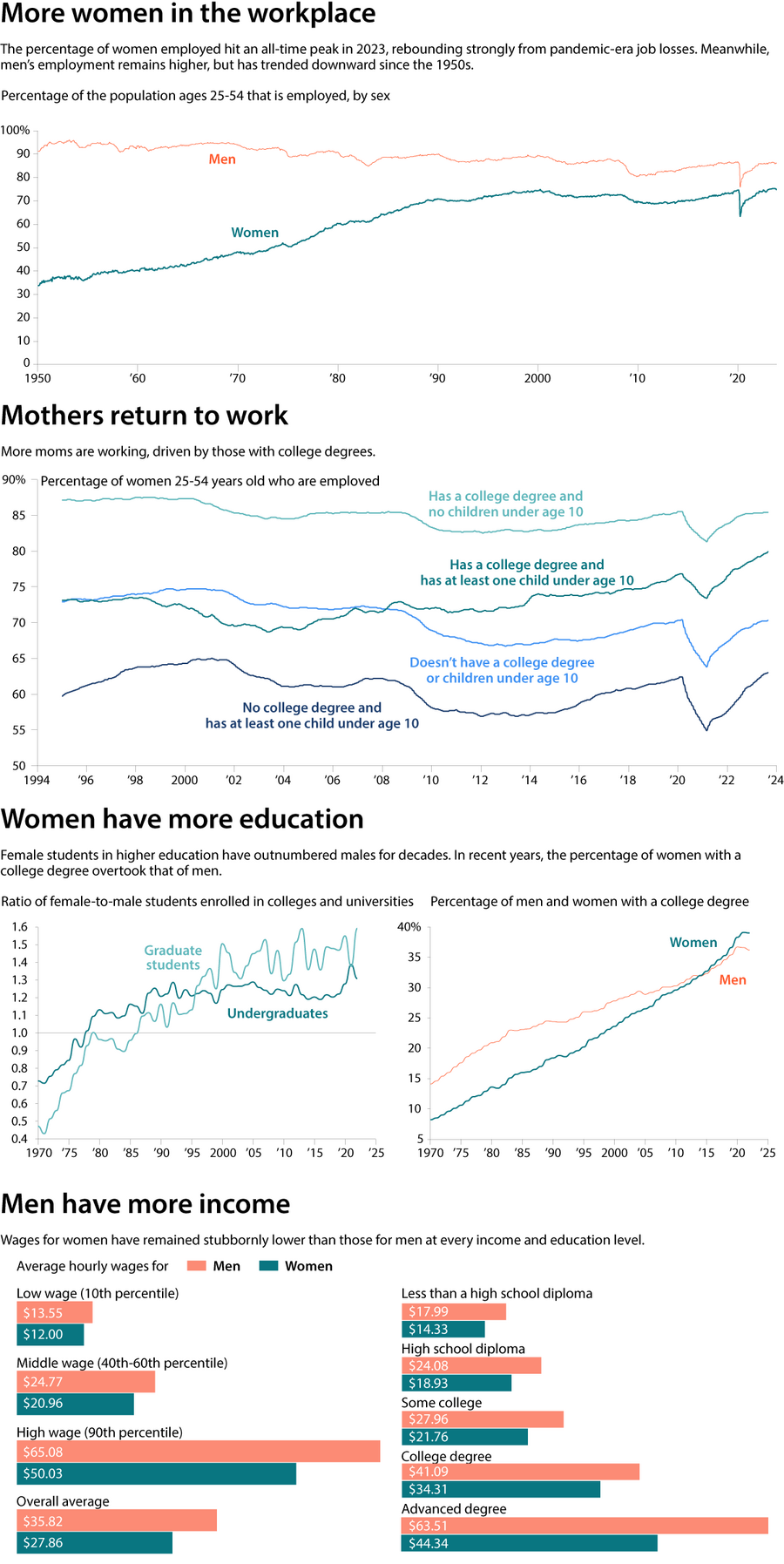
Sources: U.S. Bureau of Labor Statistics, The Wharton School of the University of Pennsylvania, U.S. Census Bureau, Economic Policy Institute

Transforming LA: This artist sees hope where others see decay
What makes a person install whimsical, unexpected art in the middle of urban blight? As LA street artist S.C. Mero sees it, there’s no better way to transform spaces – and thinking.

- Quick Read
- Deep Read ( 5 Min. )
In downtown Los Angeles, absurdity interrupts urban blight: A fire hydrant sprouts stockinged legs; a winged telephone leaps from a phone booth; a mailbox towers, inaccessible, over passersby.
The city’s historic business district and surrounding neighborhoods are the backdrop for contemporary street artist S.C. Mero, who sees opportunity in a landscape dogged by disappointment and deferred dreams. The Minnesota native embraced the area, known as DTLA, after graduating from the University of Southern California a decade ago. Today, her rogue installations are part of downtown’s creative fabric – and local authorities are in on it. She’s been honored by the city for her contributions to the Skid Row neighborhood and commissioned by the nearby Fashion District to decorate a median at an intersection.
Transformation governs her art. Ms. Mero’s first pieces were mosaics made of pennies, which she altered with heat, dye, and tools. Other projects reshape abandoned spaces into commentaries on politics and humanity.
Her work insists on hope, which she describes as rebellious. “To put something like cute little turtles on a median with downtown the way it is, it’s resisting something, right? It’s resisting the default, which is to be negative,” she says.
Transforming LA: This artist sees hope where others see decay
In downtown Los Angeles, absurdity interrupts urban blight: A fire hydrant sprouts stockinged legs; a winged telephone leaps from a phone booth; a mailbox towers, inaccessible, over passersby.
The city’s historic business district and surrounding neighborhoods are the backdrop for contemporary street artist S.C. Mero, who sees opportunity in a landscape dogged by disappointment and deferred dreams. The Minnesota native embraced the area, known as DTLA, after graduating from the University of Southern California (USC) a decade ago. Today, her rogue installations are part of downtown’s creative fabric – and local authorities are in on it. She’s been honored by the city for her contributions to the Skid Row neighborhood and commissioned by the nearby Fashion District to decorate a median at an intersection.
Transformation governs her art. Ms. Mero’s first pieces were mosaics made of pennies which she altered with heat, dye, and tools. Other projects reshape abandoned spaces into commentaries on politics and humanity.
Her work insists on hope, which she describes as rebellious. “To put something like cute little turtles on a median with downtown the way it is, it’s resisting something, right? It’s resisting the default, which is to be negative,” says Ms. Mero.
The Monitor spoke with Ms. Mero at Something Poetic, her venue for performance art. The space, offered to her during the pandemic by the Historic Core Business Improvement District, has become a hub for local artists. The conversation has been edited for clarity and length.

Why downtown? You joined an artist collective on Skid Row after graduating from USC. I’m guessing there were other options.
I think my mom asked me the same question all the time. I just feel like it’s a good fit for what I’m doing. It’s really a creative vortex. ... You have the Arts District, the Flower District, the Fashion District, Little Tokyo, you have the Industrial District, the Financial District. And maybe that’s typical of most cities, but I feel like there’s a lot happening here and it’s good for cultivating ideas.
I’ve just felt like I want to see it through, too. Look at these [historic, vacant] buildings. I think this could come back to life and they’re not there yet. So I want to be part of that transition.
How do you keep tapping into that hope?
I have a lot of faith. I just feel like I’m in constant communication with a higher power, whatever created me. And a lot of my work is in communication with that constantly. I’ll be walking around and I’ll hear, I don’t want to say a voice, but something like, “Pay attention to that. Pay attention to this.” It’s this relationship that I have with the neighborhood, but also a higher power. And I feel like the more that you commit to it, the more it continues to give to you. I just keep listening.
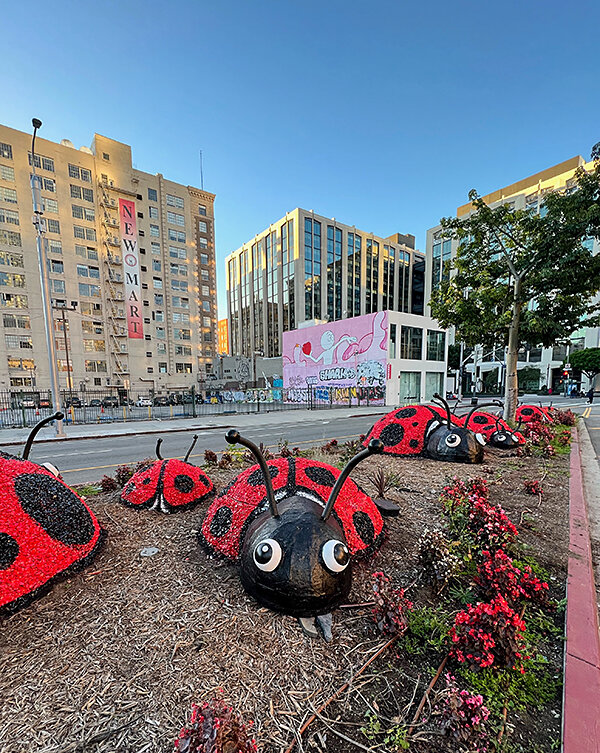
You look at a pothole, you look at something breaking down around you, and you see whimsy and light. How does that happen?
Because nobody cares about it anymore. It’s free game, right? Nobody’s going to stop you from really, truly doing anything on a pay phone right now, or a newspaper stand, or – in certain areas – a pothole. Like a penny – you can pick it up and you can play with it, because it’s in that state of decay. It has a lot of opportunity to take it in a new direction. And you’re not going to get a lot of resistance or pushback. To do anything to it, people are like, ‘Oh, you know, it’s better than what was there.’
What do you want people to take away from your art?
I feel like wanting people to take away something is in a way thinking that I want something from them – a certain reaction or a certain whatever. And because it gives me so much, I’m thankful that they are even allowing me to do it. So the fact that their reaction is positive, I’m just even more grateful for that – it makes it a little easier to be able to keep doing it. So I don’t know if I want a certain reaction from people. I just hope that they can find something that they do that they love as much as what I’m doing.

Is there a theme or an idea that pulses through your work?
Yes. At first I didn’t really see it. I feel like a lot of my work is reactionary and intuitive. I grew up playing sports and it feels very much like that, just responding to the environment and making an art piece, not trying to overthink it. At first when I was doing the penny [mosaics] and then I was doing the start of my indoor work and outdoor work, I felt like maybe I should do one and not the other one. But I started to realize that they are communicating the same idea, which is the age-old idea of spiritual growth and transformation. And I think that that’s evident in a lot of my work – the whole idea that something can lose its identity or lose its value, but then come back even stronger.
A lot of my work is critical of our government, but I still maintain hope that there is a better way. It speaks to the truth because it’s not really about a payphone or a penny. We’re no different than that, right? Something is that way, but it can be better. What does it take for that to happen? It takes a belief, for one. It’s not going to get better by not thinking or imagining or seeing it that way.
What is the relationship between your work and the downtown community?
They’re as much of a part of it as I am. It’s that we’re-in-this-together kind of vibe. Whether they like the piece or not, they get it because they’ve seen that pothole. They’ve seen a payphone like that, or they’ve walked by this or that. So it has that sense of camaraderie, I think. I hope it does.
Other headline stories we’re watching
(Get live updates throughout the day.)The Monitor's View
A final push for female equality
- Quick Read
- Deep Read ( 2 Min. )
-
By the Monitor's Editorial Board
Last year, the World Economic Forum forecast that it would take five generations to achieve gender equality in every nation. Now the World Bank wants to rapidly accelerate that time frame.
The international financial institution is poised to launch a strategy aimed at significantly advancing the rights and economic opportunities for girls and women by 2030. The plan focuses on improving inclusivity and resilience through access to finance, technological innovation, and changes in public policy and law.
“Recent research demonstrates that both social norms and mindsets can change, for example, that engaging men and boys can foster their support and buy-in for gender equality,” a consultative draft of the plan states.
Shifts in thought are harder to quantify than bank loans for rural women or school enrollment for girls. The bank’s plan would target norms and institutions that may still require generational shifts. It has taken Rwanda more than two decades to establish itself as a model for land reforms that boost economic empowerment for women.
“No one benefits if women are held back,” Rwanda President Paul Kagame said, arguing for land reform in 2015. “We have to change mindsets, not just the laws.”
The World Bank hopes to spread that message.
A final push for female equality
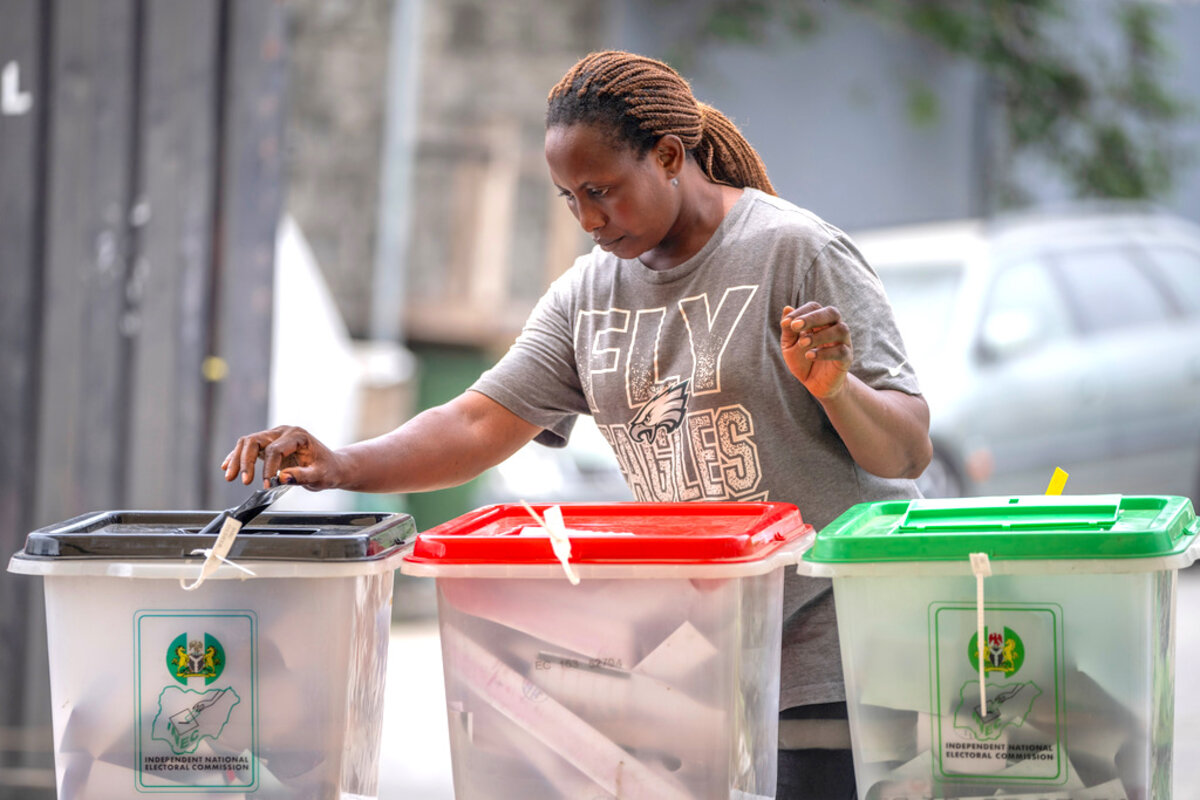
Last year, the World Economic Forum forecast that it would take five generations to achieve gender equality in every nation. Now, the World Bank wants to rapidly accelerate that time frame.
The international financial institution is poised to launch a strategy aimed at significantly advancing the rights and economic opportunities for girls and women by 2030. The plan focuses on improving inclusivity and resilience through access to finance, technological innovation, and changes in public policy and law.
“Recent research demonstrates that both social norms and mindsets can change, for example, that engaging men and boys can foster their support and buy-in for gender equality,” a consultative draft of the plan states. “Positive gender outcomes can be accelerated and scaled with a better understanding of ... how social norms and mindsets shape everyday expectations, priorities, and practices.”
Shifts in thought are harder to quantify than bank loans for rural women or school enrollment for girls. Yet there is plenty of evidence that female agency can move mountains. In Iran, for example, women have led the greatest threat to the Islamic government in 40 years simply by refusing to comply with laws that force them to cover their hair. . In some of the 130 countries with minimum quotas for female representation in government, such as India, male resistance to female voting and political activism has eased.
In some rural African communities, civil society organizations are replacing a harmful rite of passage with health education. One such program helped Kamanda Timayio, leader of the Masai village of Maparasha, Kenya, change his mind about female genital mutilation. He told Le Monde that he had “emerged from ignorance” and would abandon the practice.
The World Bank cites other examples. From 1970 to 2022, Bangladesh quadrupled female literacy rates and doubled female participation in the labor force. Its gross domestic product more than tripled. The change gathered its own momentum. Recruiting salaried women as teachers and health workers from within their own communities boosted trust “and made women’s mobility and work more socially acceptable.”
The bank’s plan would target norms and institutions that may still require generational shifts. It has taken Rwanda more than two decades to establish itself as a model for land reforms that boost economic empowerment for women. “No one benefits if women are held back,” Rwandan President Paul Kagame said, arguing for land reform in 2015. “We have to change mindsets, not just the laws.”
The World Bank hopes to spread that message.

A Christian Science Perspective
Each weekday, the Monitor includes one clearly labeled religious article offering spiritual insight on contemporary issues, including the news. The publication – in its various forms – is produced for anyone who cares about the progress of the human endeavor around the world and seeks news reported with compassion, intelligence, and an essentially constructive lens. For many, that caring has religious roots. For many, it does not. The Monitor has always embraced both audiences. The Monitor is owned by a church – The First Church of Christ, Scientist, in Boston – whose founder was concerned with both the state of the world and the quality of available news.
A call to exercise spiritual perception
- Quick Read
- Read or Listen ( 4 Min. )
-
By Michael Brown
We can look to the Bible for inspiration that opens our eyes to God’s goodness, which is always present.
A call to exercise spiritual perception
There is little in our human experience that seems more impressive than what we see. The pictures the world presents include war, disease, poverty, racial tensions, fraught relationships, and personal tragedies, right alongside things we consider to be good.
The Scriptures, however, encourage a second look to perceive what’s really present where these dark images seem so real, and highlight the contrast between the commonly accepted view of everything as material on the one hand, and spiritual perception, or the apprehension of God, Spirit, and His perfect, spiritual creation, on the other.
God, infinite good, is the only creative power and the singular source of our being, which is therefore spiritual, not material. So, to behold something spiritually is to perceive the harmony of this divine Truth as a present fact, where before the observer had seen only a limited, material picture.
A beautiful example of this is the account of the prophet Elisha at Dothan (see II Kings 6:8-17). The king of Syria, frustrated that his army’s tactics were proving ineffective against the Israelites, suspected a spy within his own ranks. When his advisors explained that it was actually Elisha in Israel who, through his prophetic office, was revealing Syrian plans to the king of Israel, the king tasked his army with capturing the prophet. Soon after, Elisha’s young servant stepped outside to discover that they were surrounded by a powerful military force, complete with horses and chariots. His fearful reaction was understandable based on the picture before him: “Alas, my master! how shall we do?”
Elisha’s response is remarkable: “Fear not: for they that be with us are more than they that be with them.” His prayer is a simple call to exercise spiritual perception: “Lord, I pray thee, open his eyes, that he may see.” The result? “And the Lord opened the eyes of the young man; and he saw: and, behold, the mountain was full of horses and chariots of fire round about Elisha.”
This reveals that scientific prayer is not a request for God’s supernatural intervention in a material world, but rather an act of spiritual perception that brings into view the ever-present reality of God’s infinite goodness and power already at hand. It is this perception of Truth that corrects, clarifies, and heals.
This story took on new meaning for me while I was serving as a chaplain in the United States Navy. On one occasion, I was deployed with my Marine Corps unit to a combat position in Syria. Our post was in an embattled village that had, until a few months before, been a base for violent extremists, who had terrorized the local population and much of the Middle East. I was there to bring spiritual perspective and nourishment to the unit.
A couple of days after my arrival, we held a simple church service, during which I shared the story of Elisha at Dothan. I pointed out to these young men that they had a choice before them. They could see all around them the stark and disturbing picture of a brutal war – or they could open their eyes to the ever-presence of God, good, and His government.
It was a moment of real celebration – not of a military victory but of a mental one. It was the recognition that right where evil seemed to rear its head in dramatic fashion, right there we could celebrate God’s presence and rejoice in His power to supply freedom, peace, and security.
In the following months, the unit’s mission was completed, and all the Marines and sailors returned safely home at the end of the deployment, for which I remain deeply grateful.
Mary Baker Eddy describes this distinction between false, material sense and spiritual perception. In her book “Science and Health with Key to the Scriptures,” she writes, “Human sense may well marvel at discord, while, to a diviner sense, harmony is the real and discord the unreal” (p. 563).
We can daily, even hourly, consider what God is and what He knows about us and our situation. Understanding God as ever-present, all-knowing, and all-powerful Life and Love, we can rest assured that Love is caring for our every need and surrounding us with evidence of Life’s goodness.
The beauty of spiritual perception is that it is not the exercise of some force of our own will. Rather, it is a humble turning away from a material sense of our world, however impressive, and allowing God to reveal to us the perfect, spiritual reality that Christ Jesus brought to light in his healing ministry. God has provided us with the innate ability to do this. Our task is simply to see what God has revealed.
Adapted from an article published in the Aug. 16, 2021, issue of the Christian Science Sentinel.

Viewfinder
Child advocate
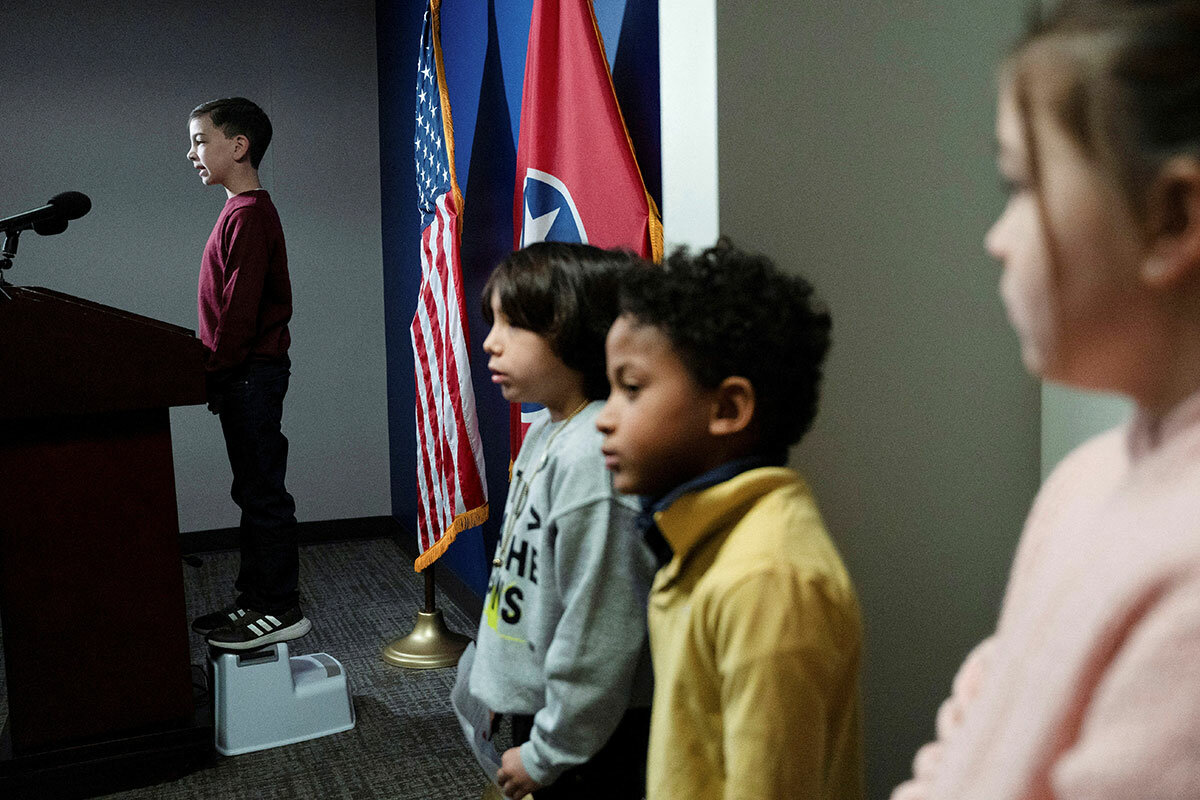
A look ahead
Thank you for joining us today. Tomorrow, we’ll have two stories about important developments in the year ahead. The first looks at how the Supreme Court is unexpectedly having a much bigger year than the justices anticipated – or probably wanted. We’ll also explore the ramifications of “the year of the election.” More than half the world’s adults will vote this year. What will that mean?
We hope you’ll come back for those stories and more.



